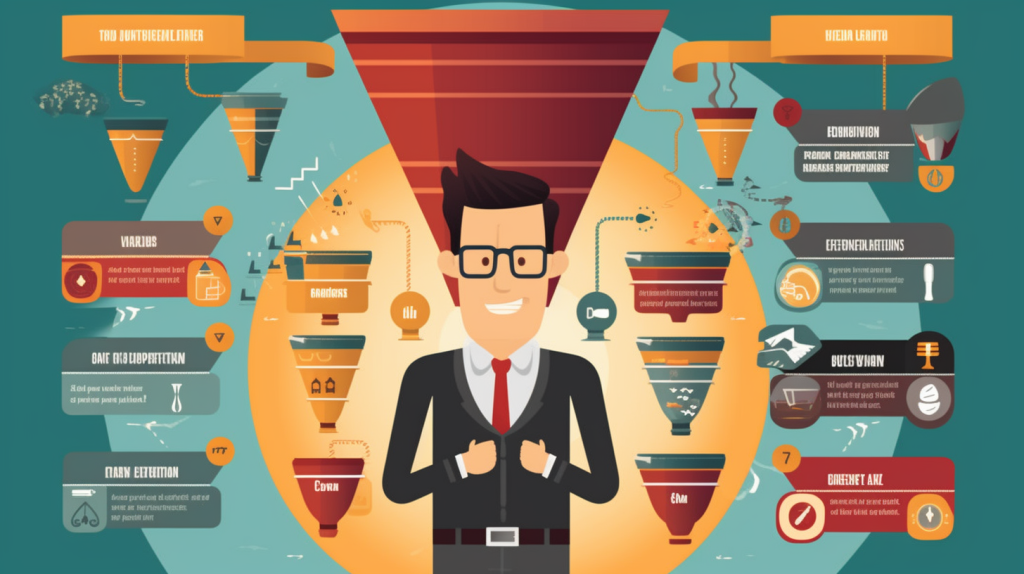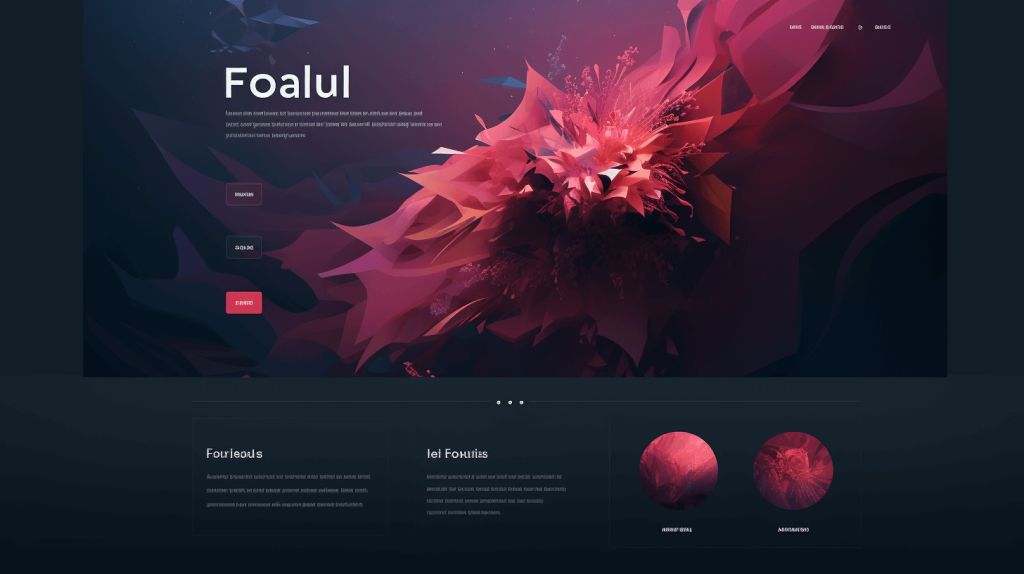The Power of Sales Funnels: A Comprehensive Guide to Understanding and Optimizing Your Marketing Strategy
Table of Contents
In the dynamic landscape of online marketing, sales funnels have emerged as a vital tool for businesses to drive conversions and maximize revenue.
By understanding the concept of sales funnels and their key stages, you can effectively guide potential customers through the buyer’s journey, leading them to take action and become loyal customers.
In this blog, we will delve into the world of sales funnels, explore each stage’s purpose and significance, and examine how the buyer’s journey aligns seamlessly with this powerful marketing framework.
1. Understanding Sales Funnels

A. Defining the Concept of a Sales Funnel
A sales funnel is a comprehensive and dynamic framework that provides a visual representation of the customer journey, encompassing all the stages a prospect goes through before ultimately converting into a paying customer.
It serves as a strategic guide for businesses to effectively navigate and optimize their sales process, from the initial point of contact to the final purchase or conversion.
The sales funnel metaphor draws its inspiration from the shape of a funnel, reflecting the gradual narrowing down of prospects as they progress through each stage. At the top of the funnel lies the stage of awareness, where potential customers first become aware of a business or its products and services.
This stage involves generating brand awareness and capturing the attention of a wider audience. Through various marketing efforts such as advertising, content creation, social media engagement, and search engine optimization, businesses strive to attract and engage potential customers, making them aware of their offerings.
As prospects move further down the funnel, they enter the stage of interest. At this point, they have shown some level of engagement or curiosity about the business, indicating a genuine interest in exploring its products or services.
This stage involves nurturing the leads generated during the awareness stage, providing them with valuable information, educational content, and personalized experiences to deepen their interest and establish a connection.
The subsequent stage in the sales funnel is the decision phase. Here, prospects evaluate the available options, comparing different solutions and considering their specific needs and preferences.
Businesses need to showcase the unique value and benefits of their offerings, addressing potential objections and providing persuasive arguments to encourage prospects to choose their products or services over competitors.
The final stage of the sales funnel is the action stage, which marks the conversion or purchase. At this point, prospects have made the decision to move forward and become paying customers.
The goal of this stage is to facilitate a smooth and seamless transition, ensuring that the purchasing process is effortless, convenient, and meets the customer’s expectations. This can involve providing clear and compelling calls-to-action, streamlined checkout processes, secure payment options, and exceptional customer service.
It’s important to note that the sales funnel is not a rigid structure and can vary across industries, businesses, and marketing strategies. Some funnels may include additional stages or sub-stages, depending on the complexity of the sales process.
Moreover, the length of time and level of engagement required to move prospects through the funnel can vary significantly, depending on factors such as the industry, target audience, and the complexity of the products or services being offered. (click here to learn how to automate that process 🙂
By understanding and effectively utilizing the concept of a sales funnel, businesses can strategically map out their customer journey, optimize each stage of the funnel, and implement targeted marketing and sales tactics to drive conversions and achieve business growth.
B. The Purpose and Significance of Each Stage
1. Awareness: At the awareness stage, businesses aim to grab the attention of potential customers and create brand awareness. It involves generating interest and curiosity about your products or services through effective marketing channels. The goal is to make your target audience aware of their needs or problems and position your brand as a solution.
2. Interest: Once you have captured the attention of your audience, the interest stage comes into play. Here, you nurture leads by providing valuable content, educational resources, and engaging experiences. The purpose is to build trust and credibility, fostering a strong connection with your prospects.
3. Decision: The decision stage is where prospects evaluate their options and make a decision based on the information they have gathered. At this stage, businesses need to present their offerings as the best solution to meet the prospect’s needs. This involves highlighting unique selling points, addressing objections, and providing social proof to instill confidence in the decision-making process.
4. Action: The action stage is the culmination of the sales funnel, where the prospect takes the desired action, such as making a purchase, signing up for a subscription, or requesting a consultation. This is the ultimate goal of the sales funnel, and it represents the conversion of a lead into a paying customer.
C. Aligning the Buyer’s Journey with the Sales Funnel
The buyer’s journey is the process an individual goes through when making a purchase decision. It aligns seamlessly with the stages of a sales funnel:
1. the awareness stage signifies the realization of a problem or need. Prospects actively seek information to address their concerns and explore potential solutions.
2. Interest: As prospects progress through the buyer’s journey, they enter the interest stage, where they gather information, compare options, and evaluate different brands. This aligns with the interest stage of the sales funnel, where businesses provide valuable content to educate and engage prospects.
3. Decision: The decision stage in the buyer’s journey mirrors the decision stage in the sales funnel. Prospects weigh the pros and cons, assess pricing, features, and benefits, and narrow down their options. It is crucial for businesses to position themselves as the preferred choice during this stage.
4. Action: Finally, the action stage of the buyer’s journey corresponds to the action stage of the sales funnel. This is where the prospect makes the purchase or takes the desired action based on their evaluation and decision-making process.
2. Understanding Your Target Audience: Key Steps to Tailoring Your Sales Funnel for Success
In the fast-paced world of marketing, achieving success relies heavily on understanding and connecting with your target audience. Without a clear understanding of who your ideal customers are, it becomes challenging to create an effective sales funnel that truly resonates with their needs, desires, and preferences.
In this blog post, we will delve into the significance of identifying your target audience and explore the crucial steps involved in tailoring your sales funnel to specific customer segments. By following these steps and implementing targeted strategies, you can significantly increase your chances of driving conversions, boosting customer engagement, and building long-lasting relationships with your customers.
Step 1: Define Your Target Audience
The first step in tailoring your sales funnel is to define your target audience. Start by conducting thorough market research to gain insights into the demographic, psychographic, and behavioral characteristics of your potential customers.
This includes factors such as age, gender, location, interests, pain points, motivations, and purchasing behaviors. By developing a clear picture of who your target audience is, you can create highly targeted marketing messages and tailor your sales funnel to meet their specific needs.
Step 2: Conduct Market Research

Market research plays a vital role in understanding your target audience and their preferences. There are various techniques and tools available to gather valuable data, such as online surveys, focus groups, competitor analysis, customer interviews, and social media listening.
By analyzing the data collected through market research, you can uncover valuable insights about your audience’s behaviors, preferences, and pain points. This information will serve as a foundation for crafting targeted marketing messages and developing a sales funnel that resonates with your potential customers.
Step 3: Create Buyer Personas
Once you have collected and analyzed the necessary data, the next step is to create buyer personas. Buyer personas are fictional representations of your ideal customers, based on the insights gained from market research.
These personas encompass various characteristics, including demographics, behaviors, goals, challenges, and buying preferences. Creating detailed buyer personas helps you humanize your target audience, allowing you to understand their needs and motivations on a deeper level.
With well-defined buyer personas, you can tailor your marketing messages, content, and sales funnel to cater to the specific pain points and desires of each persona.
Step 4: Align Sales Funnel Stages with Customer Journey
To effectively tailor your sales funnel, it’s crucial to align the stages of the funnel with the customer journey. Each stage of the funnel should correspond to a specific phase of the customer’s decision-making process.
For instance, the awareness stage should focus on capturing attention and generating interest among your target audience. The consideration stage should provide valuable information, address pain points, and build trust.
Finally, the conversion stage should make it easy for customers to take the desired action and complete a purchase. By aligning your sales funnel with the customer journey, you can guide potential customers seamlessly through each stage and increase the likelihood of conversions.
Step 5: Personalize Marketing Messages and Content
Personalization is key to tailoring your sales funnel for success. Use the insights gained from market research and buyer personas to craft personalized marketing messages and create targeted content that speaks directly to your audience’s needs and desires.
This can involve segmenting your email lists, creating dynamic landing pages, and delivering personalized recommendations based on past behavior or preferences.
By delivering relevant and personalized experiences, you can engage your target audience on a deeper level, increase their trust in your brand, and enhance the overall effectiveness of your sales funnel.
In conclusion, understanding your target audience is crucial for tailoring your sales funnel to drive success.
By defining your target audience, conducting market research, creating buyer personas, aligning the stages of the funnel with the customer journey, and personalizing your marketing messages and content, you can create a sales funnel that resonates with your potential customers, boosts conversions, and cultivates long-lasting customer relationships.
Remember, effective targeting and personalization are the keys to unlocking the full potential of your sales funnel and achieving marketing success.
3. Identifying Your Target Audience

A. The Importance of Understanding Your Target Audience
1. Niche Targeting: Identifying your target audience allows you to focus your efforts on a specific niche market. By catering to the unique needs and preferences of this audience, you can differentiate your brand and create a competitive advantage.
2. Personalized Messaging: Understanding your target audience enables you to craft personalized and relevant messaging that resonates with them. By speaking directly to their pain points, aspirations, and motivations, you can establish a stronger connection and increase the likelihood of conversions.
3. Efficient Resource Allocation: By identifying your target audience, you can optimize your marketing resources. Instead of casting a wide net, you can allocate your budget, time, and efforts more efficiently by targeting those who are most likely to be interested in your products or services.
B. Techniques for Conducting Market Research and Gathering Customer Insights
1. Surveys and Questionnaires: Use surveys and questionnaires to gather information directly from your audience. Ask relevant questions about their demographics, preferences, and behaviors to gain valuable insights.
2. Social Listening: Monitor social media platforms, online communities, and forums to listen to conversations about your industry, products, or services. This helps you understand the needs, challenges, and sentiments of your target audience.
3. Competitor Analysis: Study your competitors to gain insights into their target audience. Analyze their marketing strategies, customer interactions, and positioning to identify gaps and opportunities.
4. Customer Interviews and Focus Groups: Conduct interviews or organize focus groups to delve deeper into your target audience’s motivations, pain points, and buying behaviors. These qualitative insights can provide valuable context and understanding.
C. Tips for Creating Buyer Personas
1. Demographic Information: Gather demographic data such as age, gender, location, and income to create a comprehensive profile of your ideal customer segments.
2. Psychographic Insights: Dive into the psychographic aspects of your target audience, including their interests, values, lifestyle, and aspirations. This helps you understand their motivations and decision-making processes.
3. Pain Points and Challenges: Identify the key pain points and challenges your target audience faces. This allows you to position your products or services as solutions to their specific problems.
4. Buying Behavior: Analyze the buying behavior of your target audience, including their preferred channels, purchasing frequency, and decision-making factors. This helps you tailor your sales funnel to meet their expectations.
5. Tailoring Your Sales Funnel: Once you have created buyer personas, use them as a foundation for tailoring your sales funnel. Craft targeted messaging, design relevant content, and create personalized experiences at each stage of the funnel to cater to the specific needs of each persona.
4. Crafting High-Converting Landing Pages: Unlocking the Power of First Impressions

Understanding the Significance of Landing Pages
Landing pages serve as targeted entry points for your potential customers. They are specifically designed to provide a focused and streamlined user experience, presenting visitors with a compelling offer, valuable information, or an opportunity to take a specific action.
Unlike other web pages, landing pages have a singular purpose: to guide visitors towards a specific conversion goal, such as making a purchase, subscribing to a newsletter, signing up for a free trial, or downloading a resource.
Tips for Designing High-Converting Landing Pages
1. Clearly Define Your Conversion Goal: Before diving into the design process, clearly define your conversion goal. Determine the specific action you want visitors to take on your landing page and align all elements towards that objective. Whether it’s completing a form, making a purchase, or signing up for a service, a focused and well-defined goal will ensure a streamlined user experience and increase the likelihood of conversions.
2. Craft Compelling Headlines: Captivating headlines are vital in grabbing visitors’ attention and immediately conveying the value proposition of your offer. Use clear, concise, and benefit-driven language that resonates with your target audience. A well-crafted headline can entice visitors to continue exploring your landing page and take the desired action.
3. Create Persuasive and Concise Copy: Your landing page copy should be persuasive, concise, and focused on communicating the unique benefits of your offer. Highlight the value proposition and explain how it solves a specific problem or meets a particular need. Use persuasive language, storytelling techniques, and social proof (such as customer testimonials) to build trust and credibility with your visitors.
4. Utilize Engaging Visuals: Incorporate visually appealing elements such as relevant images, videos, or infographics that reinforce your messaging and create a positive user experience. Visuals can help break up the text, convey information more effectively, and evoke emotions that drive engagement and conversions. Ensure that your visuals are optimized for fast loading times and responsiveness across different devices.
5. Implement a Clear and Compelling Call-to-Action (CTA): Your call-to-action (CTA) button is the gateway to conversions. Make sure it stands out visually, uses action-oriented language, and clearly communicates the next step for visitors to take. Position the CTA button strategically on the page, ensuring its prominence and ease of use. Experiment with different colors, sizes, and placement to optimize its impact.
6. Keep the Design Clean and User-Friendly: A cluttered or confusing design can hinder user experience and deter visitors from taking the desired action. Keep your landing page design clean, uncluttered, and visually appealing. Use whitespace effectively to guide visitors’ attention to key elements and make the content easy to digest. Ensure that the page is mobile-friendly, loads quickly, and is intuitive to navigate.
7. Test and Optimize: Successful landing page design requires ongoing testing and optimization. Implement A/B testing to experiment with different variations of headlines, copy, visuals, and CTAs. Monitor key metrics such as conversion rates, bounce rates, and time on page to identify areas for improvement. Continuously iterate and refine your landing page elements based on data-driven insights.
8. By following these tips and incorporating the essential elements of effective landing pages, you can create a powerful first impression that engages visitors, builds trust, and drives conversions. Remember, a well-crafted landing page is a critical component of your sales funnel, and mastering its design can unlock the full potential of your digital marketing efforts.
5. Creating Compelling Landing Pages

A. The Role of Landing Pages in a Sales Funnel
1. Capturing Attention: Landing pages serve as the first point of contact between your potential customers and your brand. They are designed to capture attention and entice visitors to take the desired action, whether it’s making a purchase, signing up for a newsletter, or requesting more information.
2. Generating Leads: Landing pages are powerful lead generation tools. They provide an opportunity to collect valuable information from visitors, such as email addresses, names, or preferences, allowing you to nurture these leads further down the sales funnel.
3. Tailoring Messaging: Unlike your website’s homepage or other pages, landing pages allow you to tailor your messaging specifically to a targeted audience or a particular marketing campaign. This customization increases relevance and helps create a stronger connection with your visitors.
B. Tips for Designing High-Converting Landing Pages
1. Clear and Concise Messaging: Keep your messaging focused, concise, and aligned with your marketing objectives. Clearly communicate the unique value proposition and benefits of your offering to captivate your visitors’ attention.
2. Attention-Grabbing Headlines: Craft compelling headlines that immediately grab your visitors’ attention and create intrigue. Use powerful and benefit-driven statements to highlight what sets your product or service apart.
3. Engaging Visuals: Incorporate eye-catching visuals that align with your brand and complement your messaging. Use high-quality images, videos, or graphics to enhance the overall visual appeal of your landing page and draw visitors in.
4. Persuasive Copy: Write persuasive and compelling copy that addresses your visitors’ pain points, desires, and motivations. Highlight the benefits of your offering and how it solves their problems, using persuasive language and storytelling techniques.
5. Seamless Navigation: Keep your landing page design clean and clutter-free, with a focus on easy navigation. Minimize distractions and guide visitors towards your call-to-action (CTA) buttons by removing any unnecessary links or options.
C. Elements of an Effective Landing Page
1. Attention-Grabbing Headlines: Craft attention-grabbing headlines that immediately communicate the value proposition and capture visitors’ attention. Use clear, concise, and benefit-driven language to engage them.
2. Compelling Copy: Write persuasive and compelling copy that elaborates on your value proposition, explains the benefits of your offering, and addresses visitors’ pain points. Use persuasive language, storytelling, and social proof to build trust and credibility.
3. Engaging Visuals: Incorporate visually appealing elements such as relevant images, videos, or infographics that reinforce your messaging and create a positive user experience. Ensure that visuals are optimized for fast loading times and responsiveness across devices.
4. Persuasive Call-to-Action (CTA) Buttons: Place clear and prominent CTA buttons strategically on your landing page. Use action-oriented and benefit-driven language to motivate visitors to take the desired action. Ensure that the buttons stand out visually and are easily clickable.
5. Trust Signals: Include trust signals such as customer testimonials, reviews, ratings, security badges, or certifications to build trust and credibility with your visitors. These elements help alleviate any concerns and increase the likelihood of conversions.
Conclusion
Crafting compelling landing pages is a crucial aspect of creating a high-converting sales funnel. By understanding the role of landing pages, implementing effective design strategies, and optimizing essential elements such as headlines, copy, and CTAs, you can significantly increase your conversion rates.
Remember to continually test and refine your landing pages to maximize their performance and deliver exceptional user experiences. With a well-designed landing page, you can make a powerful first impression, capture the attention of your target audience, and drive them towards taking the desired action, ultimately boosting the success of your sales funnel.
